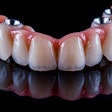
Joining CAD/CAM fabricated veneers to CAD/CAM fabricated zirconia frameworks can reduce veneer chipping frequency and speed the fabrication process. Researchers at Ivoclar Vivadent evaluated the fatigue behavior of two different systems during cyclic/static loading and found that the IPS e.max CAD-on fabrication technique with lithium disilicate is more reliable for fabricating CAD/CAM veneered restorations than Vita's Rapid Layer Technology.
They presented their findings at the recent International Association for Dental Research (IADR) meeting in San Diego.
Siegward Heintze, DDS, PhD, and his team compared the technologies in a molar crown setting. They assigned to group A Ivoclar Vivadent's method of creating a high-strength framework and veneering it with a monolithic high-aesthetic, high-strength material, lithium disilicate, that has been coated on the interior with a fusion glass ceramic and then firing it. Group B was Vita's method of joining the feldspathic superstructure Triluxe Forte to In-Ceram YZ with a composite resin.
“Using glass ceramic is a more reliable technique.”
— Siegward Heintze, DDS, PhD, Ivoclar Vivadent
Sixteen crowns from each group were adhesively luted on poly(methyl methacrylate) (PMMA) dies. Half were eccentrically loaded in a chewing simulator with a stepwise increase of load -- 3 kg to 5 kg to 9 kg -- for 100,000 cycles for each loading phase. The crowns were then examined to detect cracks, fractures, or debonding of the superstructure.
The remaining eight crowns from each group were statically loaded in a universal testing machine until failure.
Both groups performed well in terms of chipping or superstructure-debonding, which did not occur in any of the specimens, the researchers noted. However, two crowns in group B showed occlusal cracks, whereas group A showed none. The fracture load of the group A crowns was also "significantly higher," they found.
Cyclic loading did not significantly reduce the fracture load of the crowns in either group.
The crowns in group A fractured through the core, and the crowns in group B showed invariably delamination of the superstructure, the researchers noted. While no delamination of the resin-bonded veneer from the core occurred in the laboratory study, it is possible that it may happen clinically, Dr. Heintze added.
"With the glass fusion technique and a high-strength veneer material the dentist is on the safe side," Dr. Heintze concluded. “The long-term bond of composite resins to zirconia is inferior to the bond that can be achieved with the glass fusion technique and in the long run, composite resins are more prone to degradation and discoloration than ceramic”.



















